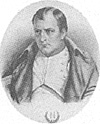Cavalry Combat at La Chaussee
3rd February 1814
Part 2: Introduction:
Dynamics of Cavalry Combat
by Andrew Field, UK
| |
In the first part of this article I gave a detailed account of the combat of La Chaussée. In this part I want to examine why things turned out as they did and to discuss some of the dynamics of cavalry combat during the Napoleonic period. I plan to do this by examining the opposing forces, both in quantity and quality, their leadership and the doctrine and tactics they used. I make no apologies that this part is actually longer than the account of the action itself!
The combat of La Chaussée was almost exclusively a cavalry affair. The Prussian infantry arrived too late to take part in the struggle and the French infantry were not in a position to influence the key, initial fighting that really decided the day for the Prussians. Their role was to be a tentative defence of La Chaussée, a withdrawal in contact and then the occupation of Baraques and the bridge over the Moivre.
‘I think,’ wrote Jürgass with reason at the end of his report of the 3rd, ‘that this day was of great honour to the Prussian cavalry’ [1]
‘Never,’ wrote Col Henckel, ‘have I taken part in a cavalry combat which had, from the first moment to the last, such order and spirit.’ [2]
These comments are a sad contrast to Marshal Macdonald’s comments on his own cavalry. In his report on this action he wrote; ‘His [the Prussian] cavalry were very audacious and I have to say, ours paled in comparison’.
[3]
In his admirable history of the campaign, Weil is very critical of the French performance, particularly their leadership and tactics. [4]
However, to get a balanced picture we should not study these two aspects of the combat in isolation, as a number of other factors inevitably had an impact on the events of the day. To fully understand the underlying reasons for the outcome of this battle it is necessary to study the realities of cavalry combat. This is explored in detail in older works such as de Brack’s Cavalry Outposts and du Picq’s Battle Studies and a number of modern studies of tactics during the Napoleonic Wars (see Bibliography). These explain that cavalry engagements were determined more by the psychological dynamics of the situation at the time rather than merely numerical or even qualitative comparisons between the two forces. De Brack states that moral effect was three quarters of the power of cavalry, [5] and this is fundamental to the understanding of its use on the battlefield.
The level of his confidence and morale tempers an individual cavalryman’s performance. These are determined by the condition and training of his horse, his own level of experience and training, his unit’s recent record of success or failure, his level of hunger and tiredness, his confidence in his comrades, his personal attachment to ‘the cause’ and his personal perspective of the situation he finds himself
in (as opposed to the real situation!). Add the competence and inspiration of his leaders and the tactics they used and we are beginning to identify the factors that will determine the performance of an individual and the probable outcome of an engagement.
Cavalry Combat at La Chaussee Part 2: 3rd February 1814
Cavalry Combat at La Chaussee Part 1: 3rd February 1814
|
